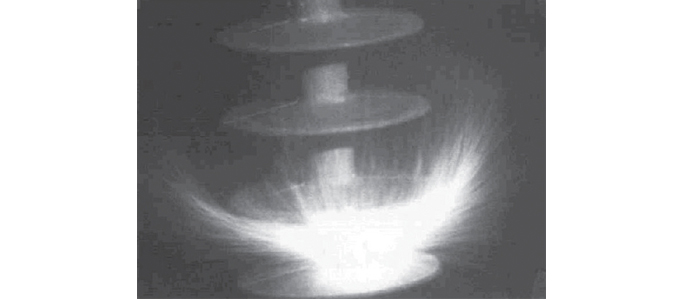- +61 7 3374 2877
- Email Us
This article examines the current state of corona discharge imaging technologies for high voltage electrical power networks. Thermal imaging has been extensively used for surveying thermal losses from buildings and industrial plant for many years, and the benefits of its application to electrical network problem detection and diagnosis are now well established. The newer cousin, corona imaging, creates an electronic image of corona discharge activity using UV light generated by the impact of excessive electric field stress on air. Corona imaging is rapidly proving itself as a very useful diagnostic tool to network operators concerned with preserving the life of the system components. Our focus will be on UV imaging in electrical power networks, outlining the corona mechanisms at work and some practical applications of these cameras.
DETECTING ELECTRICAL CORONA DISCHARGE
What is “Corona Discharge”?
Normal dry air at standard atmospheric temperature and pressure has a dielectric breakdown value of approximately 3kV/mm (3 x 106 Vm-1). The exact value varies with the shape and size of the electrodes and increases as the air pressure increases. Electrical corona discharge (commonly referred to as just “corona”) is a partial discharge in the air surrounding an electrical conductor [1]. It occurs when the electric field gradient around the conductor exceeds a minimum critical (“corona onset”) value, usually more than 2kV/mm, strong enough to ionise the gases present in the air immediately surrounding the conductor but not sufficient to ionise a complete electrical path which would result in a flash-over. The field gradients high enough to cause corona can occur over very short, localised regions close to the conductor.

Corona typically happens near a sharp point or protrusion. As the air near the conductor becomes ionised (and hence partially conductive) it has the effect of increasing the apparent size of the conductor. Since this new conductive region is less sharp, the ionisation may not extend far past this local region, thus tending to limit the corona’s extent. These high electric field gradients are usually caused either by poor design (such as choosing parameters that permit the electric field gradient to become too high in localised regions) or because something in the environment not under the designer’s control has altered since installation (such as a dirty or damaged component, increased pollution, etc.).
Why is Corona Activity a Problem?
Most of the noticeable effects of corona discharge activity are undesirable. These include power loss, audible noise, radio interference and chemical decomposition of air with consequential insulator and metal componentry damage. Interestingly, corona does act to suppress voltage surges as they pass along transmission lines, but this is believed to be its only merit.
Power Loss
Corona power loss depends on factors such as weather (temperature, pressure, humidity, wind-speed), the difference between line operating voltage and the corona onset voltage, electric field gradients, conductor surface smoothness, conductor size, and system frequency. Fair weather power loss due to corona is normally designed to be around 10% or less of the I2R loss for the transmission line concerned [2], however in some special cases (such as a very dirty transmission line, or an area with very high insect populations) corona loss can become a significant portion of the total power delivered.
Audible Noise
Audible noise can also be generated by corona discharge activity. It is usually insignificant in good weather but can become significant in conditions of visible atmospheric moisture (fog, rain). The audible noise can exceed 60db in heavy rain close to the transmission lines and be very annoying to those nearby [3].
Radio Interference
Corona activity can also generate significant radio interference. If the RIV (radio influence voltage) is exceeded, the ionisation currents can generate radio interference over a significant portion of the radio spectrum, from 0.5MHz to well over 30MHz depending on the physical geometry of the transmission line. A few milliamps of pulsing corona discharge current injected into a transmission line can cause electromagnetic waves to propagate away from the injection site in both directions, and the source can be very hard to pinpoint as the conductors can radiate this energy along their length (effectively acting as very long RF transmission aerials). The interference can be significant for up tens of kilometres on either side of the transmission line potentially leading to customer complaints.
Chemical Decomposition of Air
An area of significant concern to electrical network asset managers is the damage corona discharge can cause to network hardware components from chemical reactions triggered by the corona activity.
The main constituent gases of the atmosphere are nitrogen molecules (N2, 79%) and oxygen molecules (O2,19%). In the present of high electric field gradients, these molecules break apart and the individual atoms ionise, causing electrons to continuously gain and release energy and emit photons of various wavelengths in the ultraviolet portion of the electromagnetic spectrum.
These ionised atoms themselves undergo various chemical reactions, including the generation of ozone and various nitrogen oxides (NOx). If water vapour is also present in the air, these oxides will react with the water molecules to generate nitrous acid (HNO2) and nitric acid (HNO3) which can settle out on the surface of the insulation material, support structures, conductor spacers, corona rings or other such fixtures with the potential to cause serious damage to the component over time. Adding readily soluble pollutants (such as salt) to the mix further exacerbates this effect.